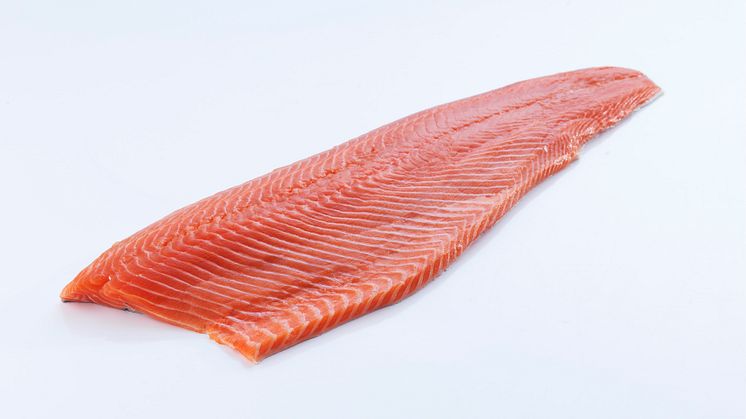
Press release -
Value of Norwegian seafood exports continues to grow – nearly NOK 11 billion in October
Norway exported 291,000 tonnes of seafood worth NOK 10.9 billion in October.
Compared with the same period last year:
- Export volume increased by 8 per cent,
- Export value increased by 9 per cent or NOK 854 million
So far this year, Norway has exported 2.2 million tonnes of seafood worth NOK 87 billion. Export volume has fallen by 4 per cent, but export value has increased by 8 per cent or NOK 6.3 billion compared to the same period last year.
“There has been significant volume growth in exports of both salmon and herring during October, which has contributed to the growth in value. This is due to increased harvesting and catches. In addition, a weak Norwegian kroner is a major contributor to seafood exports setting a new record for the month of October”, says Tom-Jørgen Gangsø, Director of Market Insight and Market Access with the Norwegian Seafood Council.
“Throughout 2019, the Norwegian kroner has depreciated against the major currencies, and this has helped to increase the export value when this is measured in Norwegian kroner. Measured against the US dollar, across the year the kroner has been 8 per cent weaker compared with the same period last year”, Gangsø continues.
“Measured against the euro and the British pound, the Norwegian krone has been approx. 2.5 per cent weaker”, concludes Tom-Jørgen Gangsø, Director of Market Insight and Market Access with the Norwegian Seafood Council.
Strong volume growth in salmon exports
Norway exported 117,000 tonnes of salmon worth NOK 6.7 billion in October. This is a volume increase of 14 per cent and a value increase of 4 per cent or NOK 261 million from October last year.
So far this year, Norway has exported 922,000 tonnes of salmon for NOK 59 billion. This is a volume increase of 7 per cent, while the value increased by 6 per cent or NOK 3.2 billion from the same period last year. The average price for whole fresh salmon in October was NOK 51.89 per kg, compared with NOK 58.35 per kg in October 2018.
Poland and France were the largest salmon markets in October.
“Good production conditions have resulted in higher production than expected. We know that Poland is a large market for seafood processing, and much of the fish that goes there is destined for consumption in other markets. In particular, dollar markets, such as Asia, have accounted for most of the export growth. Some of this can be explained by rising consumer demand. Our analyses show that growth in demand for salmon globally has been highest in China. At the same time, the Norwegian kroner has depreciated more against the dollar than against the euro, which reinforces this effect”, says Frank Isaksen, Chief Analyst at the Norwegian Seafood Council.
Focus on opportunities for increased trade
"The October numbers confirms the powerful relation between Norwegian and Chinese with regards to seafood trade. So far, we have seen an increase in both export volume and value for Norwegian exports to China. Norwegian salmon is gaining even more momentum in the Chinese market, and is taking larger shares of the market. Meanwhile, it is exciting to see that the effort being put into the pelagic species bears fruit, with increased interest for the Norwegian mackerel", says Victoria Braathen, the Norwegian Seafood Council's Fisheries Envoy to China.
A large increase in Norwegian trout exports
Norway exported 6,700 tonnes of trout worth NOK 375 million in October. This is a 46 per cent increase in volume and a 30 per cent increase or NOK 87 million when compared with from October last year.
So far this year, Norway has exported 47,000 tonnes of trout for NOK 3 billion. This is a volume increase of 31 per cent and a value increase of 25 per cent or NOK 600 million against the same period in 2018.
Belarus and the United States have purchased the most trout from Norway in October.
“The trout have benefited from the same good natural conditions for growth as the salmon, which has resulted in slightly more fish than expected earlier this year. We see a levelling off in the product mix, and the trend for more new fillet products has translated into the export of more whole fish”, says Frank Isaksen, Chief Analyst at the Norwegian Seafood Council.
Good increases in both volume and value for fresh cod
Norway exported 2,000 tonnes of fresh cod, including fillet, for NOK 107 million in October. This is a 23 per cent increase in volume and a value increase of 44 per cent or NOK 33 million when measured against October 2018.
So far this year, Norway has exported 46,000 tonnes of fresh cod, including fillets, for NOK 2 billion. This is a 21 per cent reduction in volume and a 5 per cent reduction in value, or NOK 115 million compared to the same period last year.
Sweden was the largest export market for fresh cod in October.
“Increased export volumes in October are linked to increased catches of fresh cod this year compared to the same period last year. At the same time, export prices have risen, which they are prone to do in the summer and autumn when there is less fresh cod in the market. A weak Norwegian kroner here also partly explains the price growth. At the same time, there has been a rise in prices measured in euros compared to October last year, which indicates good demand in the markets”, says Seafood Analyst Ingrid K. Pettersen with the Norwegian Seafood Council.
Norway exported 4,400 tonnes of frozen cod, including fillet, for NOK 192 million in October. The volume fell by 21 per cent, while the value fell by 16 per cent or NOK 37 million compared to October last year.
So far this year, Norway has exported 58,000 tonnes of frozen cod, including fillets, for NOK 2.4 billion. Export volume remains at the same level as last year, while value has grown by 15 per cent or NOK 314 million, compared to the same period in 2018.
The UK and China were the largest markets for frozen cod in October.
Portugal was the largest cod market in October
Norway exported 12,100 tonnes of whole clipfish for NOK 698 million in October. This is an increase in volume of 18 per cent, and a value increase of NOK 202 million or 41 per cent compared to October last year.
So far this year, Norway has exported 77,000 tonnes of clipfish for NOK 3.9 billion. This is a 2 per cent increase by volume and a 13 per cent, or NOK 439 million increase in export value against the same period last year.
Portugal and Brazil were the largest clipfish markets in October.
“After a slightly weaker start to the year, measured in volume, exports of codfish have increased in recent months and are now on a par with last year. Especially in October, exports have been significantly higher than at the same time last year. The increase has been almost 24 per cent, up to 5,200 tonnes. The price has also had a steady increase throughout the year. Much can be explained by a weak krone against both the euro and the US dollar, but also by demand in markets such as Portugal”, says Ingrid K. Pettersen, Seafood Analyst with the Norwegian Seafood Council.
“Most of the cod clipfish goes to Portugal, and so far this year Portugal has taken an even larger share than usual for this period. There has been a significant reduction in the export of salted fish from Norway, which is included in local clipfish production. This means that importers have to buy more finished goods for Christmas sales”, says Johnny Thomassen, the Norwegian Seafood Council's Fisheries Envoy to Portugal.
Norway exported 1,800 tonnes of salted fish for NOK 92 million in October. This is a 13 per cent volume reduction and a 7 per cent, or NOK 7 million reduction from October 2018. Portugal and Italy were the largest export markets for salt fish in October.
So far this year, Norway has exported 21,000 tonnes of salted fish for NOK 1.2 billion. This is a 21 per cent reduction in volume, and a 12 per cent reduction in value, or NOK 160 million from the same period last year.
Herring exports increase by 91 per cent
Norway exported 38,800 tonnes of herring to a value of NOK 357 million in October. This is a volume increase of 116 per cent and a value increase of 91 per cent or NOK 170 million compared with October last year.
So far this year, Norway has exported 216,000 tonnes of herring for NOK 1.9 billion. This is a 10 per cent increase in volume, and a 5 per cent decline in value, or NOK 93 million from the same period last year.
Nigeria and Egypt were the largest herring markets in October.
“The increase in export volumes is a consequence of doubling the volume of catches, measured against October last year. The increase in exports is mainly for frozen whole herring, and the price has fallen compared with October last year. Price-sensitive markets in Africa, including Nigeria and Egypt, have increased the supply of frozen whole herring”, says Ingrid K. Pettersen, Seafood Analyst at the Norwegian Seafood Council.
Price increases for mackerel
Norway exported 66,000 tonnes of mackerel worth NOK 1.3 billion in October. This is a volume decline of 14 per cent but a 2 per cent, or NOK 29 million growth in value compared to October 2018. Mackerel has seen a solid price increase this year, also partly driven by a weaker Norwegian kroner.
So far this year, Norway has exported 173,000 tonnes of mackerel for NOK 3.1 billion. This is a 2 per cent increase in volume, but a significant value increase of 26 per cent, or NOK 634 million, measured against the same period last year.
In October, Japan was the largest market for mackerel.
“This is the most important time of year for Norwegian mackerel exports. Here in Japan, we have worked hard for a long time to communicate the strengths of Norwegian mackerel. Norwegian mackerel remains popular with Japanese consumers, who see Norwegian mackerel as a premium product”, says Gunvar L. Wie, the Norwegian Seafood Council's Fisheries Envoy to Japan and South Korea.
Reductions in exports of king crab and shrimp in October
In October, 161 tonnes of king crab were exported with a value of NOK 50 million. This is a 10 per cent reduction in volume and a NOK 2 million or 4 per cent reduction in export value.
So far this year, 1,800 tonnes of king crab have been exported worth NOK 557 million. This represents a volume growth of 4 per cent, while export value increased by 14 per cent or NOK 66 million.
In October, the United States was the largest recipient of king crab.
Norway exported 1,900 tonnes of shrimp worth NOK 112 million in October. This is a 12 per cent reduction, while the value of exports fell by NOK 4 million or 4 per cent.
So far this year, 14,000 tonnes of shrimp have been exported, worth NOK 933 million. There is a 57 per cent increase in volume, while the value increased by 36 per cent or NOK 249 million.
The UK and Sweden were the most important shrimp export markets in October.
“Volume growth in the UK, which we have seen so far this year, continued in October as well. One of the reasons may be fear of the possible consequences of Brexit”, says Frank Isaksen, Seafood Analyst with the Norwegian Seafood Council.
Topics
Categories
The Norwegian Seafood Council works with the Norwegian fisheries and aquaculture industries to develop markets for Norwegian seafood through local market intelligence, market development and reputational risk management. The Seafood Council is headquartered in Tromsø and maintains local representatives in twelve of Norway's most important international markets. The Norwegian seafood industry finances the activities of the Norwegian Seafood Council via a tariff on all Norwegian seafood exports.
The Norwegian Seafood Council is a public company owned by the Ministry of Trade, Industry and Fisheries.



